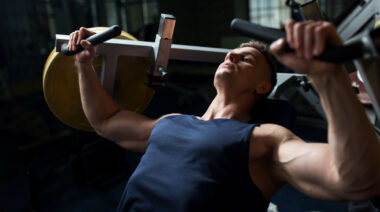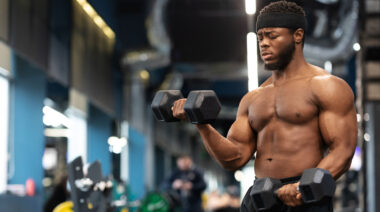The vast majority of people entering a gym for the first time are doing so with the intent to lose weight.
Sure, there are going to be a select few that want to increase size, some that want to get stronger, and fewer still who are trying to improve athletic performance. But the majority? They want to feel comfortable in their clothes, to wear a bathing suit without embarrassment, and ultimately, to look good naked.
Unfortunately, it is these same people that you are likely to see spending hours upon hours on the treadmill, eating like rabbits, and making very little progress.
The most common recommendations thrown at those looking to lose weight is to eat less and exercise more, but I would argue that this is one of the worst ways to promote fat loss, and for a number of reasons.
Foremost among those reasons is that these people probably have pretty limited muscle mass. Individuals who want to make a large lifestyle change and subsequently lose some weight are often those who have spent very little time in the gym, and typically work very sedentary jobs. As a result, they are lacking any substantial muscle.
Muscle mass is one of the key factors that contribute to our metabolic rate, so if you’re lacking in muscle, your metabolism is going to be low.1
As a result, your recommended daily energy intake is likely going to be quite low. So even though you are putting in hours and hours of endurance-based exercise, your daily energy intake is so low that it may not actually make a whole lot of difference.
Furthermore, training exclusively for cardiovascular endurance may actually raise the risk of lowering your current level of muscle mass, which in turn will reduce your metabolic rate further, making it increasingly difficult to lose weight.
But what’s the alternative?
Move Heavy Things
While the suggestion that you should strength train to promote fat loss may seem like an unconventional one, bear with me. Strength training can play a massive role in improving body composition and promoting fat loss.
This notion goes against some of the more conventional weight loss advice that is spouted by mainstream health and fitness media, but that doesn’t mean it’s incorrect. In fact, strength training can lead to a considerable amount of fat loss, without spending any time on the treadmill.
Strength provides the foundation for our ability to perform all other tasks. The greater our base level of strength, the greater our capacity for developing muscular power, and subsequently, our capacity to perform athletic movement.
Our baseline level of strength also determines our absolute work capacity, which describes the amount of physical work we can perform in a given session, and at what quality that work is performed.
The more strength we have, the greater the weight we can lift per rep, and ultimately, the more total work we can perform in a given session.
In turn, this increases the amount of total energy we expend over the course of a workout. Also, the more work we do in a session, the more damage we inflict at a cellular level, which means we will need more energy to recover.
Muscle Makes You Leaner
There is nothing worse than hearing someone say they want to get “toned.” Not because there is anything wrong with the look that they are trying to achieve, but because “toned” is a term created by the media to sell workout magazines.
It is impossible to “tone” your muscles. But it is possible to get better muscle definition. That occurs by building muscle (making them slightly more visible), and by losing the fat around those muscles, which makes them appear more defined.
Heavy strength training builds muscle.2 An increased amount of lean muscle mass relative to the amount of fat mass on our body immediately results in a decreased body fat percentage, irrespective of whether we have lost any fat or not. Pretty cool, right?
Additionally, muscle mass is highly metabolic tissue, and having more of it leads to an increase in the amount of energy we burn at rest. Seriously, by adding lean mass, you can genuinely increase the amount of energy you burn when you’re at work, on the couch, or lying in bed.
Go Heavy to Get Smaller
The amount of force we produce is proportional to the amount of muscle mass we have on our body. Heavy strength training stimulates high-threshold motor units, which leads to the recruitment of a large amount of muscle fibers.3 This neural stimulus driven by heavy lifting creates a need to maintain muscle mass.
Since fat loss requires an energy deficit, lifting heavy can help maintain muscle mass while in this deficit. Adding to the point above, this can help us maintain a high metabolic rate while still reducing caloric intake, speeding fat loss.
When strength training for fat loss, full body movements, performed in workouts three to four times a week are your best option. These sessions utilize a huge amount of muscle mass, and as such create the greatest demand for the retention of muscle tissue.
Below is an example layout for a three-day-per-week program. Exercise A and B are performed as a superset.
Day 1
- 1A: Barbell back squat 4×6
- 1B: Weighted chin-up 4×6
- 2A: Bulgarian split squat 3×8
- 2B: Dumbbell bench press 3×8
- 3A: Romanian deadlift 3×10
- 3B: Bent-over row 3×10
- 4A: Seated dumbbell press 3×12
- 4B: Lat pulldown 3×12
Day 2
- 1A: Sumo deadlift 4×6
- 1B: Band resisted push ups 4×6
- 2A: Front squat 3×8
- 2B: Inverted row 3×8
- 3A: Walking lunges 3×10
- 3B: Incline dumbbell press 3×10
- 4A: Standing overhead press 3×12
- 4B: Seated row 3×12
Day 3
- 1A: Barbell bench press 4×6
- 1B: Front squat 4×6
- 2A: High bench row 3×8
- 2B: Reverse lunges 3×8
- 3A: Decline dumbbell bench press 3×10
- 3B: Single-arm dumbbell row 3×10
- 4A: Arnold press 3×12
- 4B: Close-grip chin-up 3×12
Get Strong to Get Skinny
Strength training can lead help us reach our fat loss goals by improving our work capacity, increasing the amount of lean mass on our body (which drives up metabolic rate), ensuring muscle mass is retained in times of a dietary energy deficit, and by building motivation and adherence.
So while it may go against traditional weight loss advice, strength training can truly play a massive role in achieving your body composition goals!
How are you going to handle the other 23 hours a day?
Peer Pressure, Haters, and Sticking to Your Diet
References:
1. Zurlo, Francesco, Karen Larson, Clifton Bogardus, and Eric Ravussin. “Skeletal muscle metabolism is a major determinant of resting energy expenditure.” Journal of Clinical Investigation 86, no. 5 (1990): 1423.
2. Staron, R. S., D. L. Karapondo, W. J. Kraemer, A. C. Fry, S. E. Gordon, J. E. Falkel, F. C. Hagerman, and R. S. Hikida. “Skeletal muscle adaptations during early phase of heavy-resistance training in men and women.” Journal of Applied Physiology 76, no. 3 (1994): 1247-1255.
3. Patten, Carolynn, Gary Kamen, and Daniel M. Rowland. “Adaptations in maximal motor unit discharge rate to strength training in young and older adults.” Muscle & Nerve 24, no. 4 (2001): 542-550






